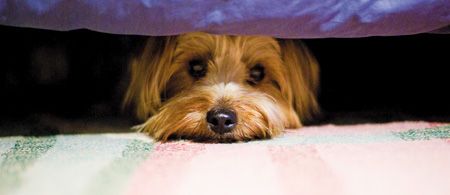Canine noise aversion: The sound and the worry
Familiarize yourself with this frightening condition in dogs and how you can best identify and overcome it.

"What WAS that?!?! I think I'll just hide out under here ..." (Getty Images)Boom! Crash! Bang!
These onomatopoeic words may have you picturing fight scenes from the '60s TV rendition of Batman and Robin. But the true sound behind each may send some of your canine patients shivering in the corner or cowering under the couch.
At a special luncheon during the CVC Virginia Beach sponsored by Zoetis, Sara Bennett, DVM, MS, DACVB, a veterinary behaviorist in Evansville, Indiana, presented an overview of this common but commonly undiagnosed behavior issue in dogs.
Learn the disturbing details
Noise aversion is a fearful or anxious response to sounds within the environment. It's what sends dogs cowering under the couch when fireworks burst in the night sky or a car backfires. The dog is distressed by the noise and wants to get away. Fireworks, thunder and gun shots are obvious triggers for dogs with noise aversion, but a wide variety of environmental sounds can also be disturbing to dogs-children shrieking, loud TV noises, doors slamming, loud engine noises, and much more, says Dr. Bennett.
She says certain dog breeds are over-represented, such as herding dogs, while others such as hunting dogs are more likely to find startling noises just part of the job.
Why do dogs develop this behavioral problem? Dr. Bennett says it could be because of1:
- Lack of habituation-the dog encounters a novel, startling sound and fails to learn that it has no consequence or meaning, continuing to show fear instead.
- Stress-induced dishabituation-the dog experienced a stressful event and was therefore at a higher level of stress at the same moment of the environmental sound and was unable to cope with the noise as it previously had, resulting in a fear response.
- Sensitization-a noise bothers the dog more and more over time, causing it to be more sensitive to it rather than learning to ignore it.
- Social transmission-the dog learned to fear a noise from another dog in the household.
Unearth the whole scary story
What can you do to catch this behavior in a dog? Just ask the owner! Dr. Bennett recommends asking all clients how the dog is at home. Specifically, what does the dog do when a loud noise occurs? Although the owner might be able to describe fear-related behavior, there might be a disconnect in recognizing that the dog is afraid.
Once this behavior condition is caught, what can you do? Several drugs, including benzodiazepines, antidepressants (e.g. selective serotonin reuptake inhibitors), alpha2 agonists, other serotoninergic medications, and supplements such as L-theanine, have been used to help calm pets or decrease their anxiety. In fact, a new medication has been formulated particularly for this form of anxiety.
Environmental management and behavior modification should be considered standard accompaniments to drug therapy, of course. Making sure the pet is in a safe secure location where it is exposed less of the frightening noise is an important first step to make it through the immediate event. Dr. Bennett says you can also slowly expose affected dogs to a recorded version of the sound they are scared of, starting at a low volume level and gradually increasing the volume-implementing systematic desensitization and counter-conditioning. However, this will not work for every dog, and for things such as thunder, it needs to be done outside of storm season.
Stop the terror today!
It's easy for owners to think that their dogs can take these momentary shivers and shakes, but Dr. Bennett says noise aversion often becomes worse over time. This can result in severely suffering patients and compromised quality of life for the pet and the owner. By asking all dog owners if this is occurring at home and taking steps now to overcome this terrifying experience, you'll be truly helping your patients live happier, healthier lives.
Reference
1. Sherman BL, Mills DS. Canine anxieties and phobias: an update on separation anxiety and noise aversions. Vet Clin North Am Small Anim Pract 2008;38:1081-1106.